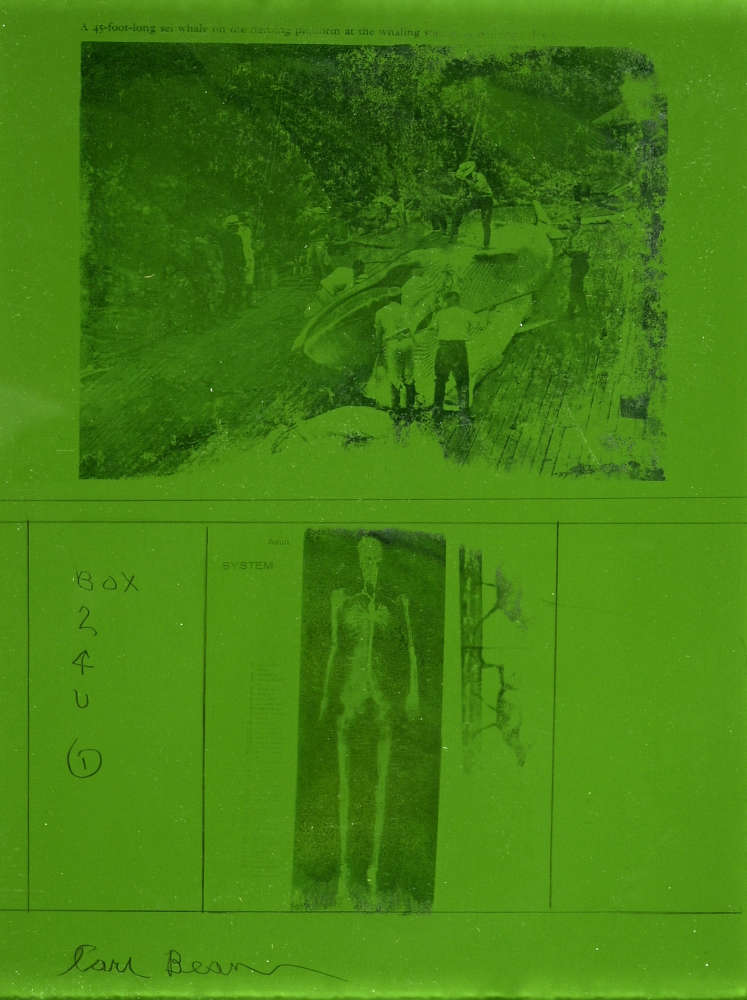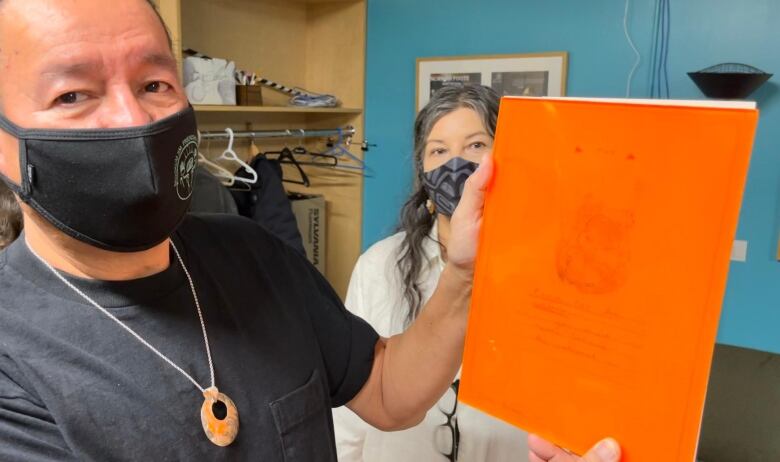Forgotten First Nations art found in basement of Yukon Friendship Centre
Among the 183 pieces found are 28 from well-known artist
Carl Beam
Staff at the Skookum Jim Friendship Centre were shocked to find 183 art pieces in their basement recently, many of them created by well-known artists.
"This recent discovery during this year of significant hardship has been a very welcome surprise," said Bill Griffis, the centre's executive director, in a news release.
The art was originally donated to the non-profit organization in Whitehorse back in 1997, but was forgotten over the years as staff left.
Among the pieces found, 28 belonged to the well-known contemporary artist Carl Beam. The other 155 were created by Stephen Snake and other Indigenous artists.
Griffis said the next step is to determine the value of each piece.
"Each one [of Beam's art pieces] has an appraisal certificate with them," said Griffis. "Part of the process is to figure out what the value is now because we have a collection [and] there may be some historical value to it."
Out of the other 155, about a third of them also had appraisals from the late 90s.
Significant impact on Canadian art sector
As one of Canada's most ground-breaking Indigenous artists, the art from Beam is of particular interest.
He was from M'Chigeeng First Nation, located on Manitoulin Island, Ont. He was born in 1943 and passed away in 2005.
Beam had a significant impact on the Canadian art sector. His work, which ranged from Plexiglass to canvas and other media, provoked conversations about the Indigenous experience of injustice in Canada.
Beam's cousin, Joe Migwans, is a long-time Yukon resident and cultural mentor.
"He was my cousin by blood, but he's more like my uncle because in our way, when we have a cousin like that, that age, he's more like my uncle. I always listen to what he said to me because he's my elder," explained Migwans.
He said Beam's work has a powerful message and is even more relevant today.
"He's basically preserving those kind of snippets in this time and telling, and it kind of like how he perceives the world to be and what his take is on it. And then in the future, people will see kind of what was going on here from from his perspective," he says.
Towards the end of his life, Beam started to talk more about what life could be or what life is all about, said Migwans.
"What it's about is overcoming and then achieving something in your life and not having to go through what you did in the past. So your life can move forward. I mean, that's the vision, right? And a lot of us back home that knew him and worked with him, we always believed that he was more well ahead of his time," he said.
Migwans said art is used to tell a story and capture a moment in time. He added that most of Beam's work came from his anger from residential schools and injustices towards Indigenous people.
"Some of the things he would like to really do was to take any stereotype around First Nations people. One of the things was saying our people were dirty Indians. Except there never was. We never were like that," said Migwans.
Beam was the first Indigenous contemporary artist featured at the National Gallery of Canada in Ottawa.
"He did it on his own in his own way. Not as a First Nations artist, as the contemporary artist, which means he's just like anybody else. He's not under the guise of First Nations or the idea that he's entitled to something because he's First Nation.
"He didn't have to use that as something to get him forward," said Migwans.
Fundraiser
Out of nearly 200 pieces, some will be sold to the public and some to private galleries across Canada.
The remaining pieces will be part of a silent auction on the Friendship Centre's website from Dec. 4 to the 14th.
The auction is part of a fundraiser between the Skookum Jim Friendship Centre and Sundog Veggies Training Farm.
Heather Finton, owner of Sundog Veggies, said the organization is grateful they can use the found art to raise some money.
"Not only is this artwork like amazing and so timely but the way that some of these gifts are going to be available to the community to support the work Skookum does is ... it's just a privilege to be part of these amazing story," she said.
The two organizations have been collaborating since 2020 for the community lunch program which feeds several families in Whitehorse. They share a goal of building food security in the Yukon and creating opportunities to develop land-based skills.
With files from Danielle d'Entremont
Art that spent over 20 years in a box could mean money for the Skookum Jim Friendship Centre and Sundog Veggies
 One of the works of art by Carl Beam that is going to be up for auction (photo: Mike Thomas, Yukon Arts Center and Sundog Veggies).
One of the works of art by Carl Beam that is going to be up for auction (photo: Mike Thomas, Yukon Arts Center and Sundog Veggies).A collection donated to the friendship centre in 1997 contains work from some famous Canadian artists.
A box of art that was sitting under at desk at the Skookum Jim Friendship Centre in Whitehorse since 1997 has turned out to contain some gold. It recently came to light that in the box was original art by the first Indigenous artist to have their work in the National Gallery of Canada in Ottawa, Carl Beam
Beam was born Ojibwe of M'Chigeeng First Nation on Manitoulin Island, Ontario in 1943. He was sent to Garnier residential school in Spanish, Ontario, at the age of 10 and stayed there until he was 18. After that, he studied at the Kootenay School of Art in 1971 and then went on to get a Bachelor of Arts from the University of Victoria. He also did graduate work at the University of Alberta between 1975 and 1976. He died at the age of 62 in 2005.
Beam became known for his mixed media style of art. He would often combine old photos of Indigenous people, news paper articles, polaroid pictures, texts, and drawings. It was his 1985 work, “The North American Iceberg” that landed him in the country’s national gallery, making history in 1986. The piece is one of his collages on a large sheet of plexiglass. It’s splattered with red, green and yellow paint and contains a self portrait of a long haired and bearded Beam.
The works of art at the Skookum Jim Friendship Centre are the same plexiglass mixed media style. There are 28 Beam originals. Many of them are brightly coloured, some yellow, some green, some red, and some orange. They show old photos of Indigenous Elders, newspaper clippings, animal pictures, and playing cards. A few have old photos of a dead whale and one has an x-ray of a human skeleton.

Above - Carl Beam collage from the donated collection (photo: Mike Thomas, Yukon Arts Center and Sundog Veggies).
The art by Beam is not the end of the box though. It also contained 155 original works of acrylic on paper by Stephen Snake, another Ojibwe artist from Ontario. Snake’s art seems to be a little more traditional than Beam’s. His paintings depict bears, fish, birds, and people with bright and pastel colours in their bold black outlines.

Above - Stephen Snake painting from the donated collection (photo: Mike Thomas, Yukon Arts Center and Sundog Veggies).
In the late 1990s, Beam and Snake donated their art to a foundation in Ontario that provided them with tax receipts. From there the collection made its way to the Council of Yukon First Nations, who then gave it to the Skookum Jim Friendship Centre. According to Michelle Kolla, the friendship centre’s executive director in ’97, no one knew what to do with it. Some of the art ended up on the walls but most stayed in the box. That was until almost 25 years later when current Executive Director Bill Griffis mentioned it to Andrew Finton of Sundog Veggies. Sundog has a training farm about 20 minutes north of Whitehorse that teaches people how to grow vegetables. Some of those veggies get donated to the friendship centre. When the two were discussing their partnership for the upcoming season, Griffis said they had some art that might be able to raise some funds. Finton admits that when he looked at the pieces, he didn’t know much about Carl Beam, but after some research he realized they had something cool.
“I don’t believe that very many people actually understood the significance of the work and how significant Carl Beam and Stephen Snake were on the Canadian art scene,” Finton told CHONfm.
They decide to use the art in an online auction to raise money for Sundog Veggies and the friendship centre.
“We plan to use the money raised to fund our lunch program. We continue to see a need for the people of Whitehorse, many of whom are homeless,” said Griffis in a statement.
Not all of the pieces will be at the auction, some will be offered for sale to public and private galleries across the country. One work titled “Poem to the Unborn” is all ready at its new home. The orange collage with a picture of a fetus on it was recently gifted to Beam’s first cousin and long time Yukoner Joe Migwans. Migwans is also from M'Chigeeng First Nation in Ontario but has been in the Yukon for the last 34 years. CHONfm reached him over the phone at the reserve where he and Beam grew up. He's there for a visit. Migwans has more of his cousin’s art, but the newly acquired work is still special to him.
“There’s so many ways he did his artwork, you know, and he said ‘to be an artist you need to work in many different forms, don’t just work in on way,’ he said ‘you need to express and work in all types,’ and he also said ‘if it doesn’t sell, why do it? Change to something else!’ Maybe that’s why he was doing all kinds,” said Migwans
“He was quite the philosopher,” Migwans added.
“To have his work is an honour,” he continued.
Migwans is an artist himself. He makes snowshoes, drums, canoes, tools, and he paints a bit too. A lot of it he learned from Beam, who was a mentor to him. Migwans knew about the art tucked away this whole time. He was the one who dropped it off there back in the day.
The collection has now been moved to a vault at the Yukon Arts Centre where it awaits the auction, which kicks off tomorrow. Finton said that paper work from 1997 shows the pieces were worth about $1000 each at that time. He said he has talked with an appraiser in Kelowna, BC but it is difficult to know what they are worth today. Finton hopes that they will fetch a decent amount of cash to though.



















